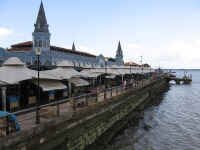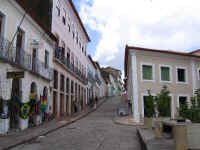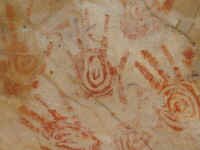First a quick note on internet cafes. We have been using them to upload all the information for the website and up to now, we have found them in every country and in every city and town, big or small. Well Brazil is different. All of a sudden the only internet cafes we can find, if they exist at all, is in the downtown "Centro" of big cities. They don't seem to exist in small towns at all. Due to the costs of satellite connection, we reserve use of our phone for emergencies. The downside is that we may have to go more than a week at a time between our updates.
August 17, 2005
We finally arrived at the port in Belem early this morning after spending about six hours allegedly waiting for the "high tide" so that we could get to the company dock. Being 150km inland from the ocean we had a hard time accepting that the tides could affect the river. So we spent another night on the barge, then waited along with the truckers to be able to drive off the barge. We waited for about 5 hours before the dock employees were willing to line our barge up with the dock so that the truckers could drive their rigs off the barge. Then we had to wait another hour while the trailers that had us blocked in were moved!
Finally, close to noon we drove out of the port. Thinking that the port west of town, we foolishly didn't ask for directions and proceeded to drive about 30 minutes the wrong way. After stopping at a couple of taxi stands, we got correct directions for Belem. We drove right into the downtown center of town and surprisingly found a great parking spot within walking distance of the markets, the waterfront and the old colonial heart of town - Cidade Velha.
We wandered along the waterfront to check out the renovation project completed by the city. Three run down warehouses were updated and now contain art displays, a museum and restaurants. The restaurants were our draw as we were famished after hanging around the dock, then driving around town. Again, we chose a traditional pay-by-weight restaurant. These are basically buffet style restaurants but the difference is that you only pay for the food you have taken.
| After lunch, we continued our walk down through the Mercado Ver-o-Peso with its four-turreted iron market as the center piece. The iron structure was ordered from Britain during the rubber boom where it was shipped in pieces to be assembled here in 1901. Today it serves as the main fish market, but all around it are stalls selling all manner of things. Our favorite was the area where medicinal plants and extracts were sold. The extracts had been filled into just about anything, soda bottles, plastic bottles, and the most intriguing - old vaccine ampoules. |
Across a small tidal flat is the Forte do Castelo, built by the Portuguese almost 400 years ago. As we walked towards it, our senses were overwhelmed by the smell of fish. The tide, yes, there is a tide on the river, had gone out and left nearly 100 river boats beached on the mud. All around the boats, vultures were picking at the fish heads and carcasses that the fishermen had carelessly thrown into the river - obviously not caring about the stink that they would bring.
After another couple of hours wandering down the narrow streets of the old parts of town checking out the colonial buildings, we made our way back to the Fuso so that we could find a camp spot. As it turns out, there are so many trucks on the highways that there are big truck stops for the drivers to spend the nights while they are on the road. We found a truck stop that not only had a huge are to park/camp in, but had a restaurant, repair facilities and bathrooms with showers. In the bathrooms we found that they had an electrical outlets labeled for 127volts verses the normal 220/240 volts normally found in Brazil. The electrical current in all the remaining North and South American countries is 110/120 volts. So we took out our extension cords and ran them to the outlet so that we could give our batteries a deep charge after the drain we put them under on the river.
August 18, 2005
In the morning we hit the road early, knowing that we had a long day ahead of us. We decided to take a "short cut" that would cut a couple of hundred kilometers from our drive to Sao Luis. According to our map, the road is paved and there is a ferry that crosses the river at the mouth to the ocean. That would make for an interesting trip and would keep us from having to double back on the same road. Besides, the quality of the main road was really bad, so we thought we would try something different.
Around noon, we turned off on the "short cut" and decided that if the first 10 kilometers was good (the road was about 200 kilometers long), we'd continue. The first 100 kilometers was good, so we thought we were in good shape. Late in the afternoon, the road started to deteriorate, but there was lots of traffic and big trucks on it so we continued on hoping for the best. Eventually, the road surface disappeared completely and we were driving on potholed dirt. We debated about turning around but there was still lots of traffic, so we continued to believe that there would be a ferry at the end of the road, because otherwise, what were all these trucks doing here?
About 2/3 of the way, we stopped for the night in a truck stop.
August 19, 2005
Again rising early, we continued on hoping for the best. What we found was that the road was paved through the little towns along the way, and unpaved in between. There was a lot more unpaved than paved. What we think happened was that the road was originally paved and then allowed to deteriorate first into pot-holes, then into an unbelievably bad dirt road. The roads in the towns were kept up, but that was it. We eventually hit a town called Pinheiro and turned toward the coast. The road improved slightly, but we think that was only because there was no traffic on it. Where had all the trucks gone? We figure that despite the cost, trucks (especially beer trucks) were making the one-way trip down this horrendous road, then turning around going out the same way. We decided that we would only be wasting our time if we continued the direction we were going so reluctantly we turned around. We found a different road out, but it was in terrible condition also and it took us all day to go half the distance we had traveled the previous day. We decided that in the future we will stay away from the secondary roads as they are maintained by the states - which have even less money for road improvements than the federal government.
Once again we spent the night in a truck stop.
August 20, 2005
We finally made our way to Sao Luis and discovered a charming, colonial town that is a UNESCO World Heritage Site with more than 200 buildings having been restored. It is the only city in Brazil that was founded and settled by the French. The French landed in 1612, hoping to grab a piece of Brazil from the Portuguese. They utilized the local Indigenous tribe to help them and started attacking settlements nearby. In 1614, the Portuguese fought back and took the town. Today the town is an important shipping port for the ore-rich area and is becoming an important tourist area. It also has some lovely beaches that attract the locals in droves.
We were able to do some grocery shopping at the local markets, but we were only able to find one internet cafe and its three computers were all being used. When we came back later, they were closed. This is one of the things we have found about Brazilians. They like to take about a four-hour break in the middle of the day. Unfortunately, this doesn't work very well with our scheduling, since we don't drive at night, we try to get everything done during the day, which is tough at times when things aren't open.
We spent the night at one of the beaches, parking along the street and watching the locals watching us. When we arrived, we parked in an area far from everyone else, but as the evening progressed, all the parking spots were taken and people were even parking on the grass median, going up and over the curb to do so. It was an extremely popular location and was hopping until the middle of the night. The next morning the walking paths along the beach were filled with locals bicycling, walking and/or running. Several people stopped to talk and were all amazed to find that we had driven all the way down to Brazil.
August 21-22, 2005
Driving back out of Sao Luis, we covered a lot of the same territory as yesterday. We kept looking for a propane company to fill our tank (which we use for cooking), but were unsuccessful. We stopped at a local depot, but were told that we had to find the main filling station to get our tank filled. When we arrived in Terasina, we finally found the filling station, only to be told that they couldn't fill us (for reasons that we didn't completely understand) but that we can get filled when we get to Fortaleza. Fortunately we still have about a quarter of a tank, which might even last us several more weeks (assuming that the gauge on our tank is accurate).
Terasina has the distinction of being the hottest city in Brazil. And it didn't disappoint. As we were waiting to find out if we could get our propane filled, the workers at the station brought us water to keep us cool. After waiting for over an hour, we once again hit the road. No fill today as they didn't have the "right" adapter for our valve - the same valve that they use on all of their tanks. Just bad luck, we'll try again in the next big city.
Fortunately today the roads have been pretty good so we have been making good time, but Brazil is a huge country and we have a lot of territory to cover in a relatively short period of time. So we are spending approximately two days driving and exploring one day. Our next destination is Sete Cidades National Park.
August 23, 2005
We arrived at Sete Cidades yesterday afternoon and relaxed for the remainder of the day. In the morning we arose early and went for a bird-watching hike. We saw several different types of birds and it was nice walking around in the cool early morning. We returned to the truck and had a hearty breakfast before heading off to the park office to arrange for the required guide to visit the park.
| The park has interesting rock formations that resemble cities, hence the name of "seven cities". Some of the "cities" also have interesting pictographs that are said to be between 5,000 and 10,000 years old. No one is sure who put them there and speculation ranges from Vikings to space aliens to Indigenous people (which of course is the most likely answer.) For our tour, we decided to bicycle and we followed our guide from "city" to "city" trying to understand the Portuguese description of what we were seeing. Even though it was very hot, we had a good time and the park was nice to see by bicycle. |
After our bicycle tour, we headed back out of the park and stopped at a hotel that had large grounds. They allowed us to camp and since it was so hot and we hadn't been able to locate a laundromat recently, we decided to do some laundry. After that chore was completed, we decided we deserved a soak in the hotel swimming pool and spent the rest of the afternoon relaxing and watching iguanas and birds play around the pool.
August 24, 2005
Today it was back on the road again, with the town of Fortaleza our destination. Once again we arose early and hit the road. According to our map, we would hit some bad pavement today so we knew it would be a long day. And it was. Can you imagine using a map that actually has a legend that includes "bad pavement"?! Our progress was significantly slowed by the long stretch of potholed roadway that we encountered. The 100km of potholes took us more than five hours to negotiate. We don't know how Brazil can function as a country when the roads are in such bad shape. The trucks still have to make their deliveries, but they have to sustain large maintenance bills from hitting the holes at high speeds and their delivery times would have to be delayed. On top of that, the trucks are required to stop at police inspection points, we guess to pay taxes, every time they exit AND enter a state. Very inefficient. Luckily we just zoom through with a wave at the police.
We stopped for the night at a truck stop about 30km outside of Fortaleza. As usual, we were a curiosity, but today it was the owner of the truck stop who approached us. He is a 4x4 enthusiast and was very interested in the truck. After chatting for a few minutes he offered us a nicer parking spot at his Posada and use of an inverter so we could plug in instead of running off our batteries. What a pleasant end to a long day.


